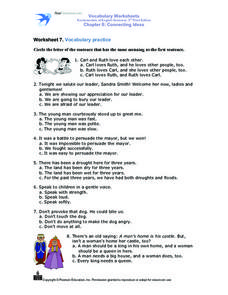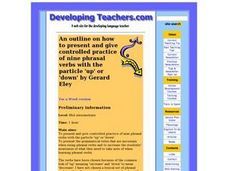Curated OER
Where Does Food Come From?
Distinguish between food and non-food items. Recognize that food is obtained from both plant and animal sources. Identify sources for some common animal foods then construct a simple food path from the farm to the consumer.
Curated OER
Practice Interview Questions
The class is learning about jobs and interviewing, but you'd like to coach them a bit more. Great! Here are a set of interview questions that include teacher notes you can use to help learners understand how to answer each question to...
Aurora City School District
Do Not Try to Kid a Kidder: The Art of Persuasion
The power to convince others of your argument lies in your knowledge of rhetoric! A thorough packet covers the basics of persuasion, including logical appeals and fallacies, and applies strategies to letters to the editor,...
Chymist
How Do We Affect the Quality of Our Atmosphere
Explore the makeup of the earth's atmosphere. Using the set of specific experiments, pupils examine the main elements and compounds present in the atmosphere. Their study extends to investigate the effects of atmospheric...
Curated OER
Worksheet 7: Vocabulary Practice
This worksheet, appropriate for upper elementary and middle school, has learners identify the meaning of words in context. They distinguish between different shades of meaning. The worksheet has seven multiple choice questions.
Virginia Department of Education
Complex Numbers
Build on your class' understanding of real numbers as they begin working with complex numbers. Pupils begin with an exploration of i and the patterns in the powers of i. After developing a definition for i, they...
Do2Learn
Fire Safety Picture Cards
Fire safety is such an important part in preparing for an emergency. Teach the class important fire safety vocabulary words. Practice a fire drill and prepare individuals on what to do in case a fire does happen at school.
Scholastic
Study Jams! Order Fractions & Decimals
Going from fraction to decimal and decimal to fraction shouldn't be a chore, but an easy step for young mathematicians to do within problems. This interactive lesson shows how long division can change any fraction to a decimal. Started...
Teach Engineering
Slinkies as Solenoids
What does an MRI machine have to do with a slinky? This activity challenges learners to run a current through a slinky and use a magnetic field sensor to measure the magnetic field. Groups then change the length of the slinky to see...
EngageNY
True and False Equations
What does English have to do with math? Teach your class the "grammar" of a number sentence. Sentences with correct grammar can be false! Understanding of a number sentence leads to a comparison with equations.
Oddrobo Software
King of Math Junior
Do your students have what it takes to be the king of math? Find out with this fun skills practice game that covers a wide range of topics from counting and basic operations to measurement and fractions.
Prezi
The Six Kingdoms
Why can't dinosaurs clap their hands? Because they no longer exist. The six kingdoms do exist, and through the presentation individuals discover kingdom names, their description, and view photographs of a few samples.
West Contra Costa Unified School District
Solving Inequalities
What does translating points on a number line have to do with solving inequalities? Young mathematicians first learn about translations of points on a number line, and then use this information to solve linear inequalities in one variable.
College Board
2014 AP® Microeconomics Free-Response Questions
What effect do dynamics, monopolies, and the balance of skilled and unskilled labor have on a market place? How does supply affect the price of gasoline? Learners consider these questions and more using College Board materials as they...
Teach-nology
The Bike Riding Moose
What would you think if you saw a moose in a tree? Read about an impressive moose and practice using context clues with a cloze passage, which includes a word bank at the bottom of the pages for kids to reference.
University of Delaware
Active and Passive Voice
Here's a handout that not only explains the difference between active and passive voice and when each form should be used, but also provides a practice exercise as well.
K12 Reader
Kick the Brick
Your class won't say ICK when they see this worksheet that focuses on -ick words! Learners read a short and silly poem containing many -ick words. They then practice reading comprehension and handwriting by tracing the answers to the...
Baylor College
Making Copies of an HIV Particle
In the second of five lessons about HIV, discover the mechanisms that allow the HIV virus to replicate. Using the models that they created the day before, learners examine the parts of the virus particle. The lesson plan does not say...
Super East Math
Long Division with Whole Numbers
Learning long division can be an difficult journey for young mathematicians, but this simple skills practice worksheet will help them on their way to fluency.
K12 Reader
The Rock in My Sock
No one likes that feeling of something pointy in their shoe! Explore -ock words and practice reading comprehension with this short poem and accompanying questions.
Curated OER
an Outline on How To Present And Give Controlled Practice of Nine Phrasal Verbs With the Particle 'up' Or 'down'
Students practice nine phrasal verbs with the particle 'up' or 'down'. They experience the grammatical rules that are necessary when using phrasal verbs.
Curated OER
Total English Advanced: What Does the Future Hold?
In this future probability practice worksheet, students interview 3 other students regarding predictions for the future and then create a written summary of the predictions.
Curated OER
What Do You See?
Pupils practice visualizing elements from a poem or story. While reading a poem aloud, the instructor models what they see as they read the passage. Students draw a picture of the main character of the story "Because of Winn-Dixie" after...
Curated OER
Unfair Or Deceptive Sales Practices
Students explore fair and unfair practices in the judicial system. They are to find sources in their own community to find help for a problem.























